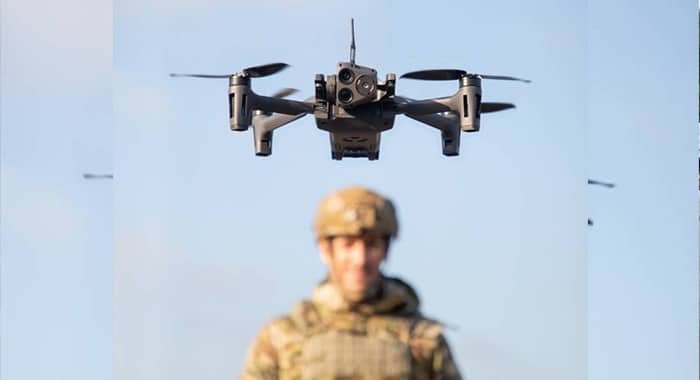As the U.S Army commemorates its 250th anniversary, the question of what kind of force it must become by 2040 is no longer theoretical it is urgent. Amid rapid advances in artificial intelligence, aerial robotics, and sensor technologies, future wars won’t be won by size alone. Victory will belong to the side that controls the tempo, dominates the contested sky below 10,000 feet, and makes faster, more accurate decisions. That means winning the fight for information.
The Army Transformation Initiative (ATI) must center on a simple but defining concept: information dominance is combat dominance. This isn’t just a doctrinal shift; it’s a redefinition of battlefield priorities. Future engagements won’t rely on the brute force of massed troops breaching enemy defenses. Instead, they will hinge on dislocating adversaries through a combination of persistent sensing, targeted deception, and lightning-fast decision-making.
The air littorals the complex, dynamic zone of airspace below 10,000 feet will become the decisive battleground. In this aerial frontier, rotary-wing aircraft, drones, loitering munitions, and electronic warfare assets constantly operate under threat. Whoever sees first without being seen, and acts before being targeted, will dominate. The Army must reimagine its formations and technologies around this reality.
The New Skirmishers: Machines and Algorithms
Traditionally, the role of forward scouts and cavalry has been to locate and shape the battlefield for the main force. In the 21st century, that mission must evolve. Armed reconnaissance now means compelling the enemy to reveal itself through movement, emissions, or reaction, and exploiting that data to disable key systems from command centers to air defense nodes.
To succeed, the Army needs a modern reconnaissance force composed of manned-unmanned teams. These formations should combine upgraded platforms like the AH-64 Apache outfitted with Active Electronically Scanned Array (AESA) radar, runway-independent drones like the Gray Eagle STOL, and cutting-edge AI systems such as TITAN (Tactical Intelligence Targeting Access Node). Together, they can track and strike high-value targets in real time, compressing kill chains and overwhelming adversaries with speed and precision.
Rather than cutting air cavalry squadrons and legacy aviation elements under budget constraints, the Army must lean into these capabilities. Apaches with AESA radar can provide long-range detection and cue fires with minimal exposure. Gray Eagles offer persistent, runway-free ISR-strike capability. TITAN nodes fuse information from national, theatre, and tactical sensors to give commanders a machine-speed edge in decision-making.
These assets are already in development. What’s needed is integration hunter-killer teams that operate ahead of main formations, sensing, deceiving, and striking to win the information battle before physical contact is ever made.
Transforming Air Defense and Exploiting Tempo
Control of the air littorals isn’t just about offense. It’s also about defense particularly against the growing threat of enemy drones. The Army must explore new applications of legacy weaponry to meet this challenge. Imagine 30 mm cannon-based systems mounted on unmanned ground platforms, configured with data links to act as mobile counter-UAS defenses. These could suppress enemy drone swarms while simultaneously enabling maneuver operations.
Future air-ground teams must be fast, mobile, and modular tailored not just to survive in contested spaces, but to manipulate those spaces for tactical advantage. To do so, traditional fires and ISR assets must be fused into a C5ISR-T architecture (Command, Control, Communications, Computers, Cyber, Intelligence, Surveillance, Reconnaissance, and Targeting) capable of delivering real-time actionability. With AI/ML support, the Army can close kill loops across domains, outpacing any enemy’s decision cycle and disrupting their ability to coordinate.
Rethinking Structure Before Restructuring
There’s a dangerous temptation in any transformation effort to lead with structure—to reshape units, cut costs, and retrofit doctrine around what’s left. But history has taught us that true transformation begins with a shift in how we fight, not what we cut. The Army should not simply reduce air cavalry numbers or retire legacy systems without a clear reimagination of their future roles.
Instead, let’s reframe these units as vanguard reconnaissance formations, equipped to dominate the information environment and shape conditions for main-force success. The future battlefield will not reward mass it will reward clarity, agility, and tempo. Investing in air cavalry, drone autonomy, AI fusion, and mobile air defenses is not just a modernisation effort. It is the creation of a new kind of formation altogether: the 21st-century skirmisher, enabled by machines, algorithms, and speed.
Information Is the First Battle and the Last
In tomorrow’s wars, the side that controls the air littorals will control the battle space. But to do so, the Army must first embrace the idea that the fight for information is the fight—not a preliminary to combat, but the decisive contest. This will require organisational courage, doctrinal reform, and sustained investment in capabilities that may not look like traditional combat power.
Winning the future does not mean discarding legacy—it means reimagining how those legacies evolve. By integrating manned and unmanned systems, empowering AI-driven decision platforms, and fielding new counter-UAS defenses, the Army can lead again in the decisive domain of 2040 and beyond: the battle for information.
Because the force that sees first and strikes fastest will always have the advantage. And in the wars of the future, that advantage will be everything.





